The Ultimate Guide to Vegan Art Supplies for Conscious Creatives
Veganism encompasses all elements of your lifestyle – which extends to the materials you choose to make art with too. While many of our creative predecessors relied on the use of animal materials in their art supplies, we now have way more choice in what’s available. Although there has been a massive increase in the number of vegan artists, it’s not always obvious what is and isn’t suitable for vegans. Here we’ve gathered together some information about vegan-friendly materials to help you shop.
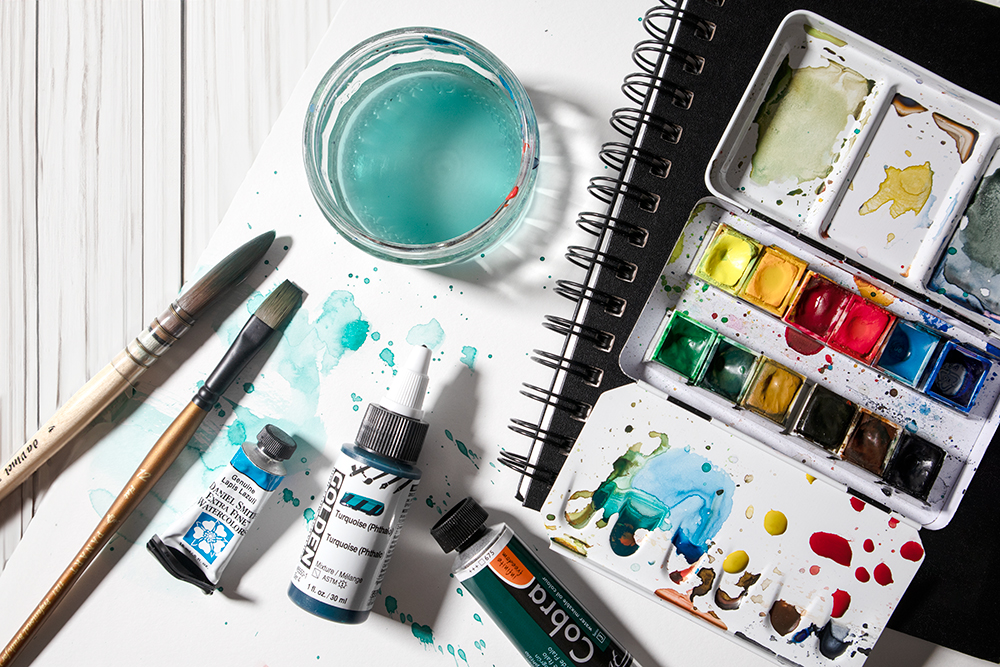
Bring up ‘Vegan Art Materials’ and you might be met with confusion. People may even conjure up images of artists eating their materials. But the truth is that veganism encompasses way more than what’s in your diet.
Historically, animal ingredients were unavoidable – whether it be animal hair in brushes, ground beetles in pigments, or animal skin paper – it would be very difficult to eliminate these materials from your practice. Thankfully, art supplies have come a long way since then, and technological advancements mean that contemporary artists have a lot more choice in the materials they use. Ultimately, transparency in the materials we use is becoming more and more important – not just for vegan artists, and not just for art supplies.
Of course, you don’t need to be a vegan to enjoy using vegan art materials. Artists may choose to eliminate animal-derived materials from their practice for all kinds of reasons. Whether you’re just looking to avoid using animal hair brushes, are slowly reducing the animal-derived materials in your studio or are eradicating the use of animal materials all together – we hope this list will help you narrow down the options available to you.
- What is Veganism? And what are vegan artists?
- How do I know if my art supplies are vegan?
- Common non-vegan ingredients in Art Supplies
- Vegan Watercolour Paints & Mediums
- Vegan Gouache
- Vegan Acrylic Paints & Mediums
- Vegan Oil Paints & Mediums
- Vegan Inks
- Vegan Brushes
- Vegan Pens & Pencils
- Vegan Pastels
- Vegan Printmaking Materials
- Vegan Paper, Canvas and Boards
- Vegan Painting & Drawing Accessories
What is veganism? And what are vegan artists?
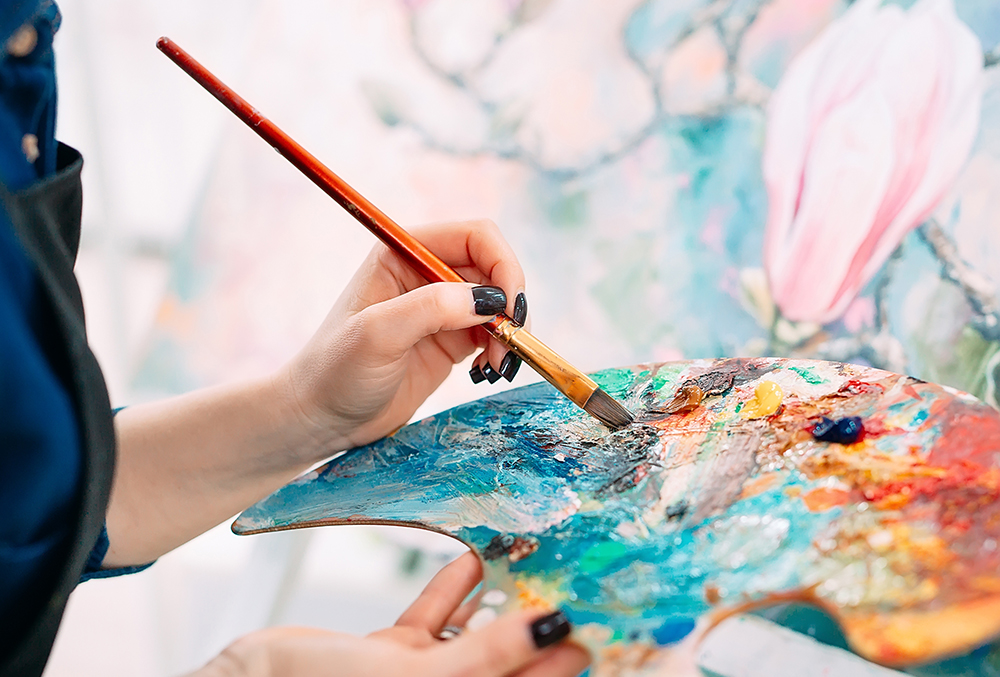
Veganism has grown exponentially over the past few years and with it has come an awareness of the materials and ingredients we use to make our favourite art materials. Rooted in the eradication of animal exploitation, vegan artists seek to eliminate animal derived ingredients from their practice and studio. Something that can be incredibly difficult as suppliers can be notoriously bad at declaring ingredients and animal testing policies.
The Vegan Society is the oldest vegan organisation in the UK, and defines veganism as the following:
“Veganism is a philosophy and way of living which seeks to exclude—as far as is possible and practicable—all forms of exploitation of, and cruelty to, animals for food, clothing or any other purpose; and by extension, promotes the development and use of animal-free alternatives for the benefit of animals, humans and the environment. In dietary terms it denotes the practice of dispensing with all products derived wholly or partly from animals.”
While not every vegan endorses the Vegan Society, the vast majority will live roughly by this mantra. One of the key phrases to takeaway from the quote is where ‘possible and practicable’. What is ‘possible’ or ‘practical’ will vary from artist to artist. While vegan artists make every effort to avoid animal products in their practice, there are no ‘hard and fast’ rules.
How do I know if my art supplies are vegan?
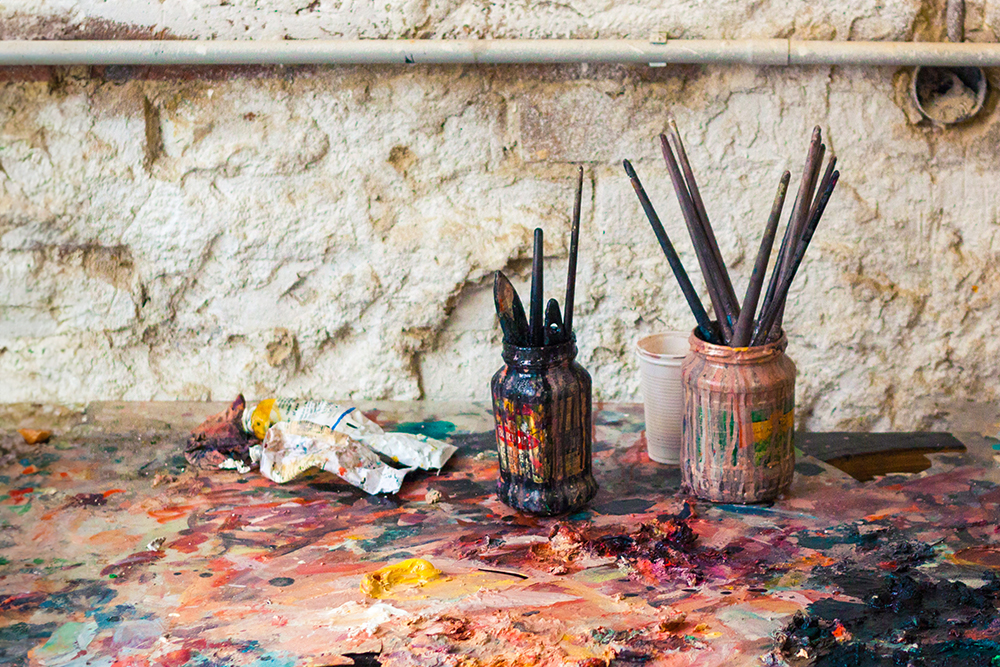
Unfortunately there is no straightforward answer. Veganism has increased in popularity dramatically over the past decades. This popularity has seen massive improvements in the labelling of food, household products, cleaning supplies and cosmetics. However, this labelling hasn’t yet carried over to art materials.
Understandably this is quite frustrating as, more often than not, any enquiries you submit to manufacturers can go months without a response. Obviously sitting around for months on end waiting for an answer doesn’t exactly foster creativity!
When it comes to vegan art supplies, you also might have come across terms like ‘vegan’, ‘ethical,’ ‘cruelty-free’ and ‘eco-friendly’ used interchangeably. People often toss these terms around, but it’s important to know that each of them carries a unique meaning. Just because a product ticks some of these boxes doesn’t automatically make it vegan.
The composition of ingredients, the materials used for packaging, and the manufacturing processes all play a role in determining the overall impact of a product. So, while a product might be vegan, it might not necessarily be ethical or eco-friendly, and vice versa. For instance, a product might be free from animal-derived ingredients, yet its manufacturing could involve practices that exploit workers. Additionally, a seemingly vegan product might have excessive plastic packaging, which raises questions about its eco-friendliness. While these considerations might not be explicitly part of veganism, you’ll find that many vegan artists will take them into account when choosing their art supplies.
Currently the Vegan Society endorse none of the brands or art materials we stock.
Common Non-Vegan Ingredients in Art Supplies
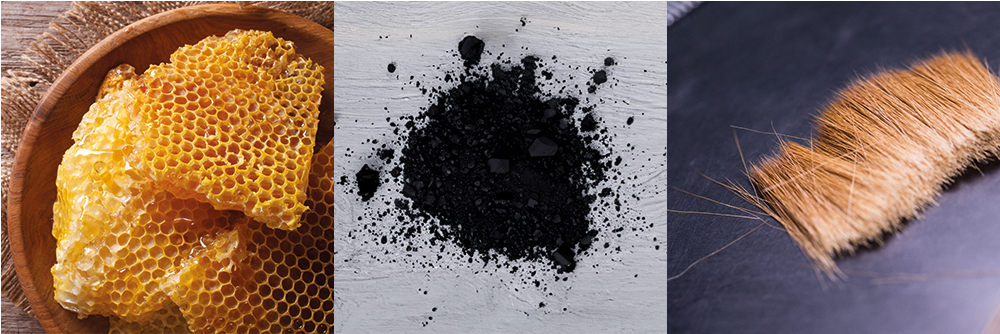
To save you some time, we’ve gathered together a list of some of the most common non-vegan ingredients that you’ll need to look out for in your art supplies:
Beeswax
Beeswax is a yellowish wax that honey bees produce. It is an ingredient in most Cold Wax Painting Mediums, encaustic painting supplies is also present in some wax pastels.
Casein
Casein is a milk protein and a primary component of Casein Paint. It is present in some types of adhesives.
Carmine
Carmine (NR4) is a red pigment derived from the kermes insect. Genuine carmine paints are uncommon as the colour is fugitive, however you can source it as a pigment powder.
Chamois
Chamois is a type of animal leather. Artists’ use chamois rags to blend charcoal and pencil.
Chochineal
Cochineal is a historical colour derived from the Cochineal insect. It produces a carmine red dye sometimes found in inks.
Egg
Egg is a primary ingredient of Egg Tempera – a gouache-like paint. Historically it has been a popular medium for icon panting and pre-dates oils.
Gelatin
Gelatine is used by some manufacturers to size paper. It is derived from collagen extracted by boiling animal skin, tendons, ligaments and bones with water.
Genuine Gesso
Genuine Gesso is made from chalk and hide glue (most commonly Rabbit Skin Glue). Modern Acrylic Gessoes are based on an acrylic formula and don’t contain animal ingredients.
Genuine Vellum
Genuine Vellum – Traditional vellum is a surface made from prepared animal skin. Artists sometimes use the word ‘parchment’ interchangeably. Vellum has mostly fallen out of favour due to low demand and a complicated manufacturing process.
Glycerine
Glycerine is a plasticiser and humectant added to watercolour paints to make the gum Arabic binder more flexible and easy to redissolve in water. Glycerine can be either plant or animal derived, as well as produced synthetically in a lab. Paintmakers use plant glycerine as animal glycerine tends to yellow with time.
Goat Hair
Goat Hair is used to make some types of brush, like traditional hakes and mop brushes.
Hog Bristle
Hog Bristle is a stiff natural hair used to make oil painting brushes.
Honey
Honey is a viscous, syrupy substance made by bees. It is sometimes added to Watercolour paints to improve their consistency. It also has antimicrobial properties.
Leather
Leather is a robust material made from tanned or chemically treated animal hides. You may come across it in storage accessories like pencil cases, brush wallets and the straps of certain Easels and boxes.
Ox Gall
Ox Gall is a wetting agent used in watercolour painting. Although it is available as its own medium, some watercolour brands include it in their paint formula. It is a type of bile obtained from the gall bladders of cattle.
PBk9 – Ivory Black/Bone Black Pigment
PBk9 is a black pigment found in paint. It is sometimes referred to as Bone Black or Ivory Black. PBk9 pigment was once obtained by burning genuine ivory. While ivory is no longer used, the pigment does still rely on the charring of other animal bones.
Rabbit Skin Glue
Rabbit Skin Glue is made by boiling the hide and bones of rabbits. It can be used to size canvases and is also an ingredient in Genuine Gesso.
Sable Hair
Sable is a natural hair obtained from various species of weasel, and commonly used in natural hair watercolour brushes.
Shellac
Shellac is a resin made from the secretions of the female lac bug. It can be used as a varnish and is also a vehicle in some inks.
Squirrel Hair
Squirrel Hair is a thin, fine natural fibre used to make watercolour brushes.
Tallow
Tallow is a rendered animal fat. It is used as an ingredient in the leads of some graphite pencils.
Wool
Wool isn’t an ingredient in many art materials, however woollen felts are used in the manufacture of some papers.
This list isn’t exhaustive but includes some of the more obvious uses of animal materials in art. Unfortunately it isn’t always going to be apparent that animal ingredients are present in your materials. On the surface a product may appear vegan, but it’s component parts may not be. Does the product contain glues or varnishes that are animal-derived? Does the packaging the product come in contain any non-vegan materials?
Vegan Watercolour Paints & Watercolour Mediums
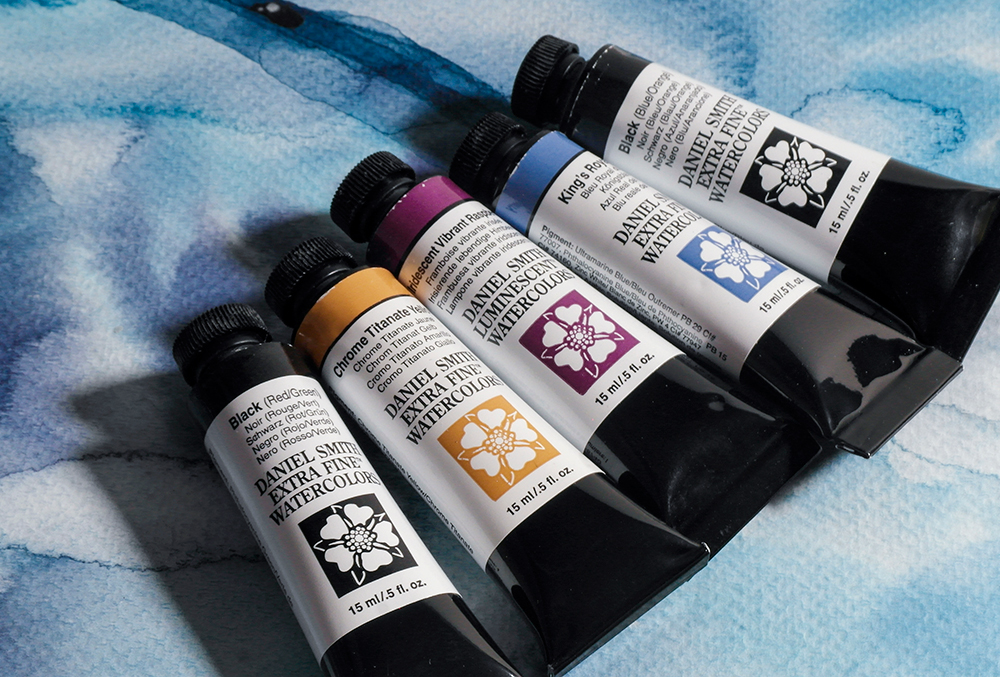
Watercolour Paints can include a few different ingredients that mean they aren’t suitable for vegans. Honey is a common additive that improves consistency and aids rewetting. Sometimes, manufacturers add Ox Gall, a wetting agent, to certain colours to enhance dispersion. Of course, there’s always the pesky PBk9 pigment to look out for. The following ranges do not contain any of these ingredients (apart from the exceptions listed).
| RANGE: | EXCEPTIONS: |
| Daniel Smith Watercolours | Ivory Black, Sepia, Payne’s Grey, Joseph Zbukvic’s Neutral Grey |
| Rembrandt Watercolours | Ivory Black |
| Schmincke Horadam Naturals | None |
| Daler-Rowney Artists Watercolours | Ivory Black |
| Rosa Gallery | None |
| QOR | Ivory Black |
| MaimeriBlu | Ivory Black |
| Van Gogh Watercolour | Ivory Black |
| Derwent Paint Pans | None |
| Cotman Watercolour | Ivory Black, Viridian Hue, Raw Umber |
| Brusho | None |
| Artful | None |
| Viviva Coloursheets | None |
| Daler-Rowney Aquafine | None |
Non-vegan watercolours include: Winsor & Newton Professional Watercolours*, Sennelier L’Aquarelle, Schmincke Horadam Aquarelle, Michael Harding and Gansai Tambi.
* Winsor & Newton do state that the following colours are the only ones that include Ox Gall in the formula: Winsor Green Blue shade, Ultramarine green shade, Alizarin Crimson, Burnt Umber, Antwerp Blue, Terre Vert, Cadmium Lemon, Cadmium Lemon, Cadmium Orange, Cadmium Red, Cadmium Red Deep, Cadmium Scarlet, Cadmium Yellow, Cadmium Yellow Deep, Cadmium Yellow Pale, Cobalt Blue, Terre Verte, Cobalt Turquoise, Cobalt Turquoise Light, Indian Red, Lamp Black, Davy’s gray, Oxide of Chrome, permanent Rose, Yellow Ochre, Quinacridone Violet, Quinacridone Violet, Prussian Blue, Sepia, Terre Verte, Winsor Orange, Winsor Yellow, Winsor Yellow Deep, Winsor Violet Diox
Vegan Watercolour Mediums
Like with Watercolour Paints, there are some main ingredients in Watercolour Mediums to steer clear of. You should avoid any additives containing Ox Gall (like Ox Gall Medium and Onetz Medium). Lifting Preparation also includes non-vegan ingredients. Schmincke Aqua Bronzes are vegan.
Vegan Gouache Paint
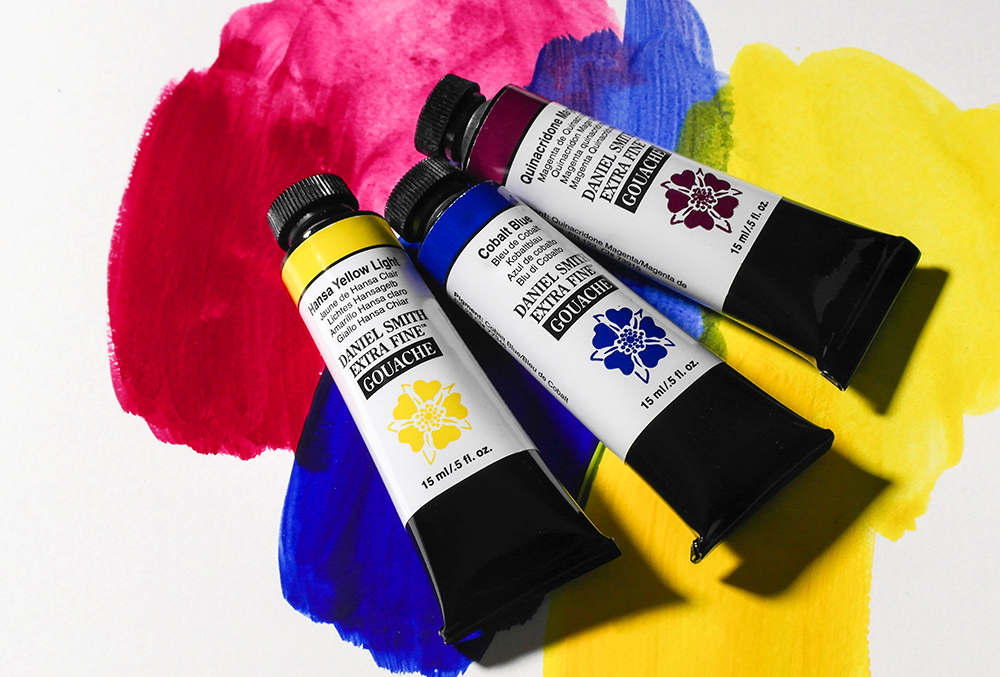
There’s a lot of crossover in the types of ingredients you’ll find in Watercolour Paint and Traditional Gouache. Traditional Gouache is made using a gum Arabic binder and some colours have ox gall added to improve wetting. Acrylic Gouache uses an acrylic resin which typically doesn’t contain animal ingredients. The following ranges don’t contain animal ingredients, with exceptions listed.
| RANGE: | EXCEPTIONS: |
| Daniel Smith Gouache | Ivory Black, Payne’s Grey and Sepia (updated June 2024) |
| Caran d’Ache ECO | None |
| Caran d’Ache Studio | None |
| Liquitex Acrylic Gouache | Ivory Black, Neutral Grey 5 and Neutral Grey 7 |
| Golden SoFlat Matte Acrylic | None |
| W&N Designers’ Gouache | Intense Blue, Primary Blue, Burnt Umber, Ivory Black, Lamp Black, Prussian Blue, Sky Blue, Winsor Green and Neutral Grey |
Vegan Acrylic Paints & Acrylic Mediums
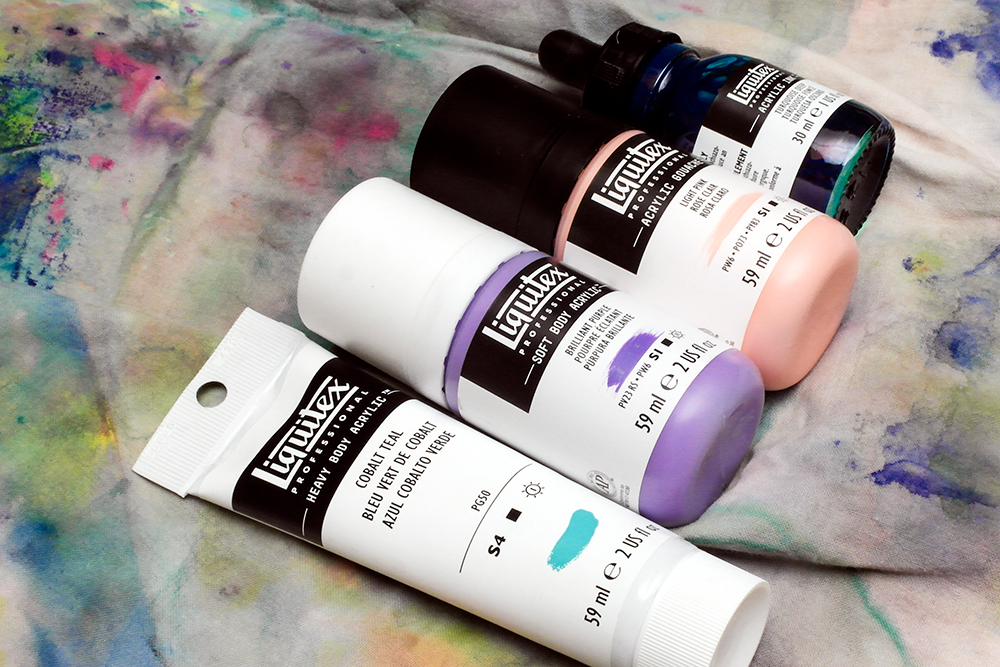
Acrylic Paints are made from artists pigments bound in an acrylic polymer resin. Typically, these resins don’t include animal ingredients, meaning the only thing you’ll need to keep an eye out for is non-vegan pigments. The ranges listed below don’t include any animal-derived ingredients, with the exception of the colours listed to the right.
| RANGE: | EXCEPTIONS: |
| Liquitex Soft Body Acrylics | Ivory Black,Paynes Grey, Neutral Grey V5, Perm Green Deep, Prussian Blue Hue, Hookers Green Deep Hue |
| Liquitex Heavy Body Acrylics | Ivory Black, Paynes Grey, Neutral Grey V5, Perm Green Deep, Prussian Blue Hue, Hookers Green Deep Hue |
| W&N Professional Acrylics | Ivory Black, Olive Green, Paynes Gray, Permanent Sap Green |
| W&N Galeria Acrylics | Burnt Sienna Opaque, Ivory Black, Paynes Gray, Raw Sienna, Vandyke Brown |
| Golden Heavy Body Acrylics | Bone Black, Jenkins Green, Neutral Greys (2,3,4,5,6,7,8), Prussian Blue Hue, Terre Verte Hue |
| Golden Fluid Acrylics | Bone Black, Jenkins Green, Prussian Blue Hue |
| Golden High Flow Acrylics | Neutral Gray 5 |
| Golden Open Acrylics | Bone Black, Jenkins Green, Neutral Gray No 5, Prussian Blue Hue, Terre Verte Hue |
| Rosa Gallery Acrylics | None |
| Daler-Rowney System3 Acrylics | None |
| Amsterdam Acrylics | Ivory Black |
| Sennelier Abstract Acrylics | None |
| Roberson Liquid Metal | None |
Acrylic Mediums
Acrylic Mediums use the same resin formula as acrylic paints, so virtually all mediums are animal ingredient free. It’s important to note that Acrylic Gesso and Genuine Gesso are not the same product. If you’re looking for a vegan Gesso then check out our Acrylic Gessoes and avoid anything described as ‘Genuine’ or ‘Traditional’ Gesso as these will contain rabbit skin glue.
Vegan Oil Paints & Oil Mediums
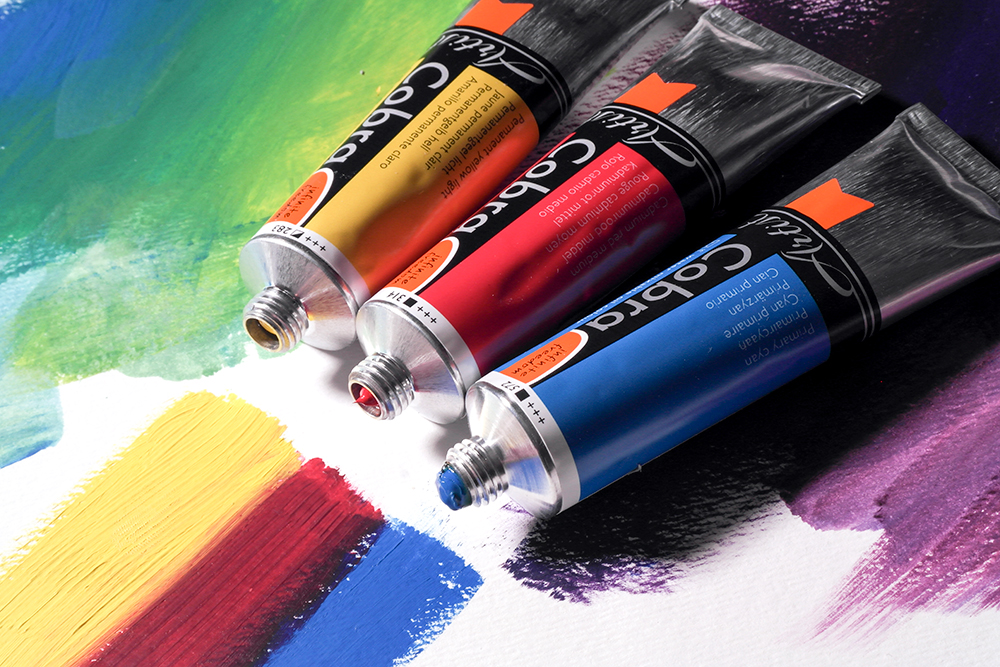
Oil Paints are essentially pigments in an oil binder. The oil binders are suitable for vegan artists as they’re vegetable based. The main ingredient to look out for in oil colours is PBk9, which you’ll find in some dark or multi pigment colours. Some ranges may also include beeswax in the binder. The following ranges are free from animal ingredients excluding the exceptions to the right.
| RANGE: | EXCEPTIONS: |
| W&N Artists’ Oil Paint | Blue Black and Ivory Black |
| W&N Griffin Alkyd Oils | Ivory Black |
| W&N Artisan Water Mixable Oils | Raw Umber and Ivory Black |
| W&N Winton Oils | Ivory Black, Van Dyke Brown and Raw Umber |
| Cobra Artists’ Water Mixable Oils | Titanium Buff, Greyish Blue, Ivory Black, Lamp Black, Payne’s Grey |
| Cobra Study Water Mixable Oils | Titanium Buff, Payne’s Grey, Ivory Black |
| Georgian Oils | Ivory Black, Blue Grey, Van Dyke Brown Hue, Raw Sienna |
| Georgian Water Mixable Oils | Ivory Black, Prussian Blue, Burnt Umber, Van Dyke Brown, Raw Sienna |
| Gamblin Artists’ Oils | Ivory Black |
| Ken Bromley Artists’ Oils | Ivory Black, Van Dyke Brown |
| Michael Harding Artists’ Oils | Paynes Grey, Ivory Black, Neutral Grey |
Oil Paint Sticks use the same formula as oil paint, but with added waxes to give them their shape. Manufacturers source these waxes from plants, beeswax, or sometimes a blend of the two. R&F Pigment Sticks use a blend of waxes in their formula, so aren’t suitable for vegans.
Oil Painting Mediums
Oil mediums consist of various ingredients, including oils, solvents, and resins – the majority of which do not contain animal components. However, there are some oil mediums that contain Beeswax – including most of our Zest-It Cold Wax Painting Mediums, Dorland’s Wax Medium, Michael Harding Resin Oil Wax Medium, Michael Harding Beeswax Paste and Michael Harding Matt Varnish. Sennelier Green for Oil mediums can contain mixture of materials from both animal and plant origins. Our supplier didn’t disclose the exact animal ingredients they use, but this range isn’t suitable for vegan artists as a result.
Vegan Inks
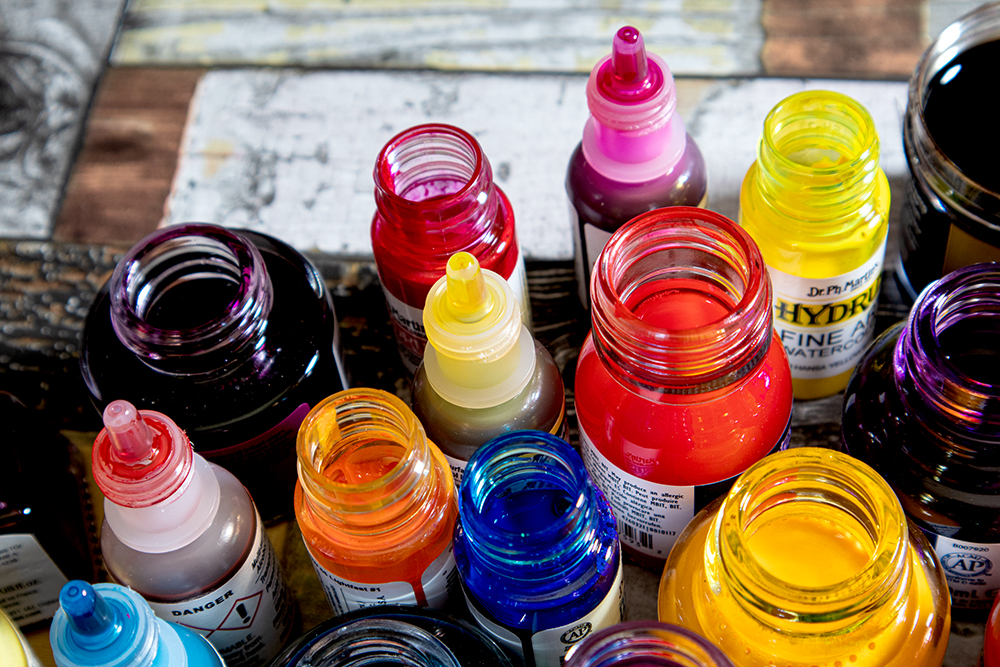
Inks cover a wide range of different mediums. The fluid inks in our list below use various binders – including acrylic resins, alcohol, shellac and more. While most binders are animal-free, shellac isn’t – so you’ll need to avoid shellac based inks. The inks below are free from animal ingredients, with any exceptions listed.
| RANGE: | EXCEPTIONS: |
| Liquitex Acrylic Ink | None |
| FW Acrylic Ink | None |
| System 3 Acrylic Ink | None |
| W&N Calligraphy Ink | White, Silver |
| Ecoline Watercolour Ink | None |
| Hydrus Watercolour Ink | None |
| Bombay India Inks | None |
| Daniel Smith Walnut Ink | None |
| Pinata Alcohol Inks | None |
Winsor & Newton Drawing Inks use shellac binder, so aren’t suitable for vegan artists.
Vegan Brushes
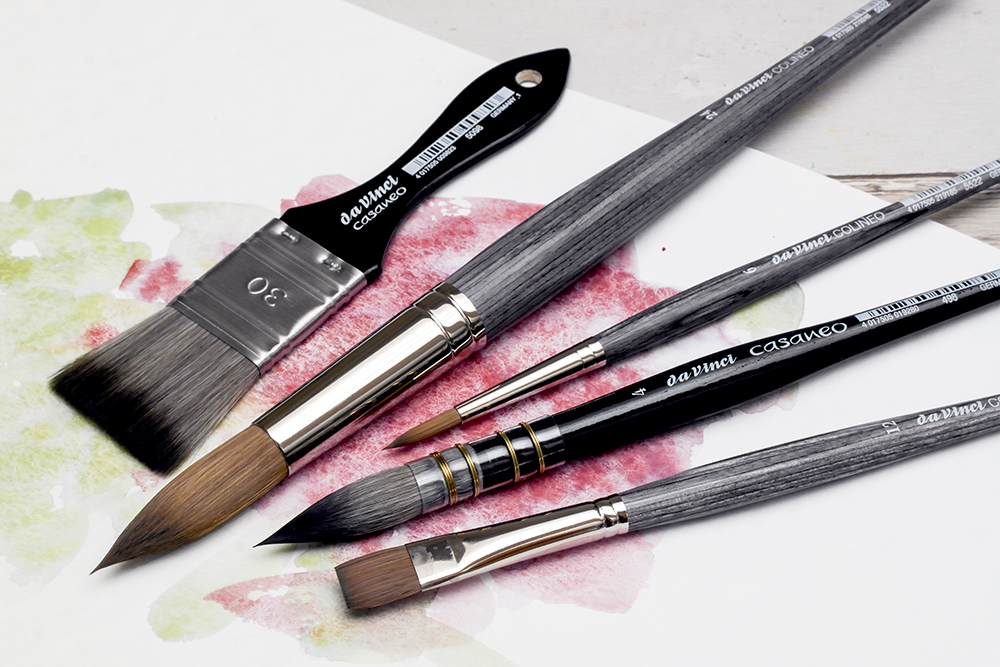
Historically, animal hair was a staple in the manufacture of artists brushes. Traditionally stiff hog bristle was the hair of choice for oil brushes, while softer sable hair was preferable for watercolour. The mid 1900s saw the first introduction of synthetic fibres, and since then the technology has come along in leaps and bounds. Brands now offer a broad range of synthetic alternatives, with some ranges even offering parity performance to their natural counterparts. We’ve included some of our most popular brushes that mimic natural hair in the list below.
In addition to the brushes in the list above, we also stock a wide range of other synthetics. Synthetics are remarkably versatile so there are all kinds of different types for watercolour, acrylics, oils, mixed media and more. Most synthetics don’t claim to offer the same performance as natural hair, but can still be a valuable edition to your toolkit. In general synthetic brushes are less expensive, and hold up better to general wear and tear. It isn’t always clear whether manufacturers use animal glues or varnishes in the finishing of brushes. The manufacturers we contacted said there were no animal ingredients in their synthetic brushes, but this won’t be true of all brands.
Vegan Pens & Pencils
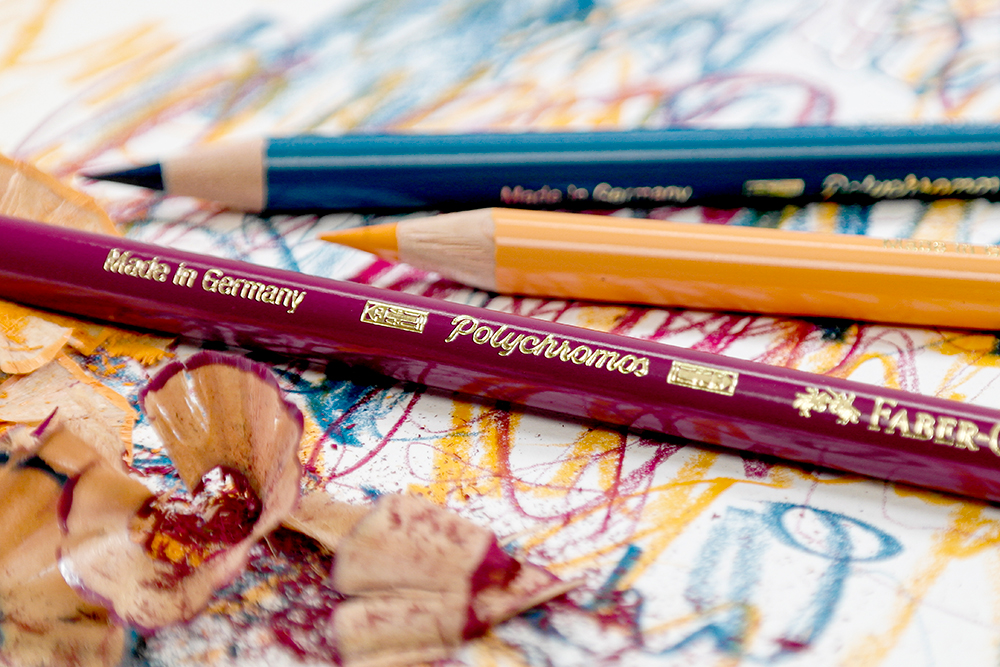
A wide range of our Pens and Pencils are vegan. One of the main ingredients used to make pencils is wax. These waxes can be of either animal or plant origin, so not all pencils will be suitable for vegans. Make sure to avoid any products listing tallow as an ingredient, as it is a type of animal fat. The ranges below are suitable for vegans excluding the listed exceptions.
| RANGE: | EXCEPTIONS: |
| All Faber-Castell Pencils & Pens | None |
| Derwent Procolour, Lightfast, Chromaflow, Coloursoft, Tinted Charcoal, Inktense, Watercolour, Graphitone, XL Blocks, Graphitint, Charcoal Blocks, Graphite Blocks | None |
| Derwent Artists | Straw Yellow, Buttercup Yellow, Orange Chrome, Spectrum Orange, Scarlet Lake, Bright Red, Geranium Lake, Rioja, Madder Carmine, Plum, Grape, Slate Violet, Phthalo Blue, Midnight Blue, Cobalt Green, Phthalo Green, Water Green, Emerald Green, Grass Green, Sap Green, Moss Green, Chartreuse, Olive Earth, Bronze, Vandyke Brown, Golden Brown, Copper Beech, Sunset Gold, Autumn Leaf, Burnt Rose, Chocolate, Ivory Black |
| Derwent Graphic | 2B through to 9B |
| Caran d’Ache Luminance | Brown Ochre, Olive Brown, Violet Brown, Light Blue, Turquoise Blue |
| Caran d’Ache Museum Aquarelle | Brown Ochre, Light Blue and Light Malachite Green |
| Caran d’Ache Prismalo, Supracolor II Soft, Fibralo Fibre Pens, Technalo, Technalo RGB, Charcoal Pencils | None |
| Winsor & Newton Studio Collection Pencils | None |
| Edding Pens | None |
| Sakura Pens | None |
| Nitram Charcoal | None |
| Viarco ArtGraf | None |
Some notable ranges that are unsuitable for vegan artists include Caran d’Ache Pablo Pencils, any non-water-soluble Caran d’Ache Graphite pencils, Conté à Paris Pencils and the Derwent Drawing pencil range.
Vegan Pastels
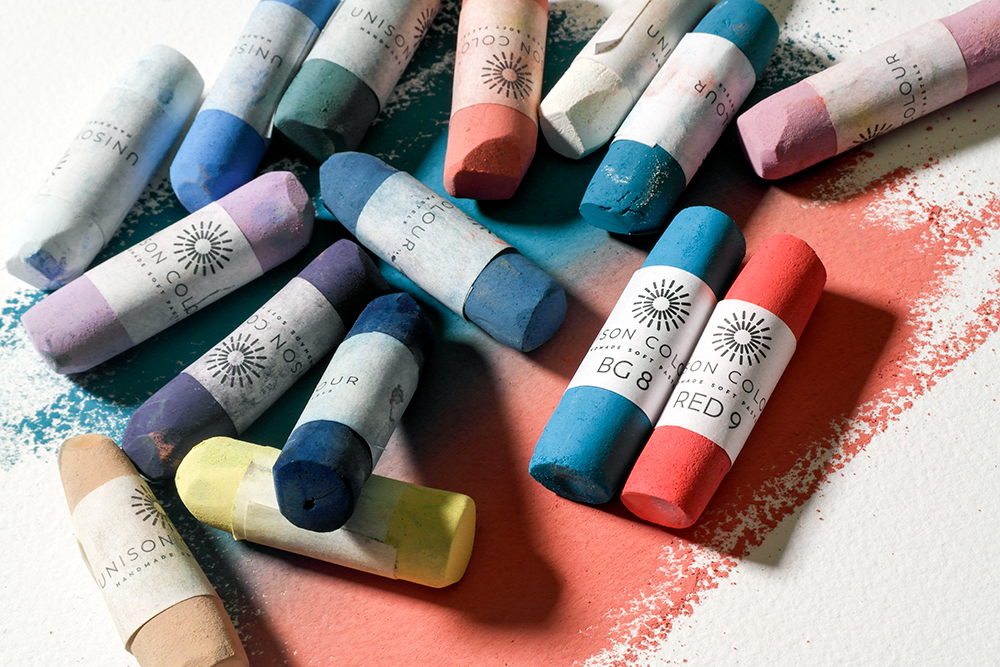
Pastel makers typically make pastel sticks using pure artists pigments and binder. While Oil pastels have a mixture of oils and waxes to bind them, soft and hard pastels typically use chalks and clays. One binding ingredient to look out for is beeswax, which is a common ingredient in wax based pastels. Some manufacturers also sometimes use bone based glues to bind together the leads of pastel pencils. The ranges listed below are suitable for vegans:
| RANGE: | EXCEPTIONS: |
| Caran d’Ache Neopastel | None |
| Caran d’Ache Neocolor II | None |
| PITT Pastel Pencils | None |
| Derwent Pastel Pencils | None |
| Unison Soft Pastels | Carbon Blacks, Dark 22, Dark 23 |
| Pan Pastels | None |
| Rembrandt Soft Pastels | None |
| Daler-Rowney Soft Pastels | None |
| Daler-Rowney Oil Pastels | None |
| Winsor & Newton Soft Pastels | None |
| Winsor & Newton Oil Pastels | None |
Some pastel ranges to avoid are Caran d’Ache Pastel Pencils as all the colours contain bone based animal glues. Neocolor I wax pastels are also unsuitable for vegans as they use beeswax in their formula. Conté à Paris pastels contain animal ingredients.
Vegan Printmaking Materials
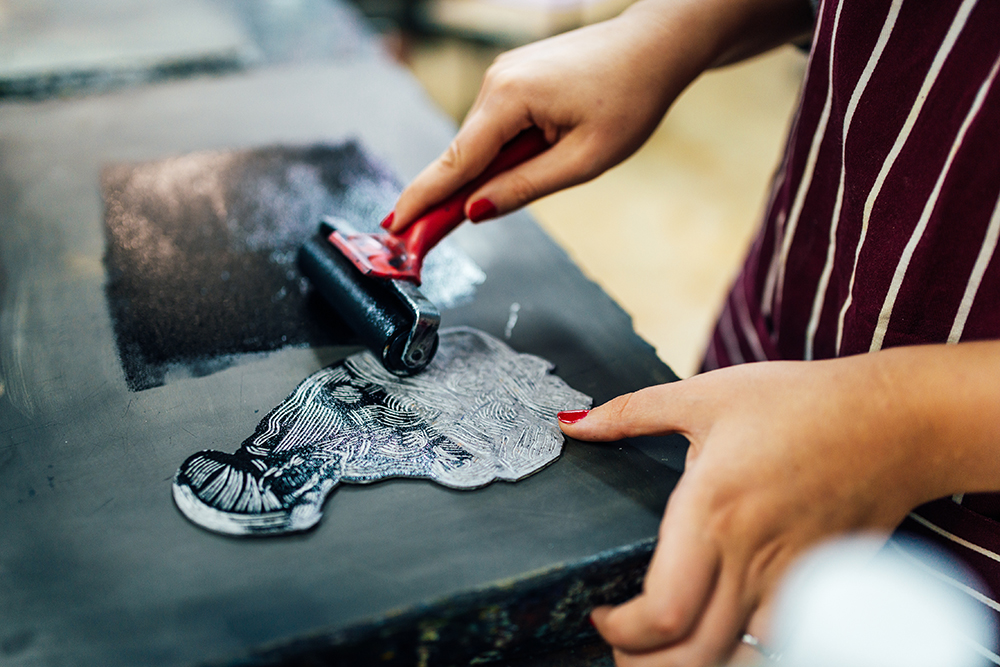
The majority of our printmaking materials are suitable for vegan artists. Both Gelli Arts and Gel Press make their gel plates with synthetic alternatives to gelatine, so contain no animal ingredients.
We stock many colours that are compatible with printmaking techniques too. Gamblin make their Relief Printmaking Inks from a vegetable oil and pigment mixture. None of the colours contain animal-derived pigments, so they’re suitable for vegan artists. Essdee state that all their printmaking materials are suitable for vegans too – this includes their accessories and all their colours. A wide range of our acrylic and oil paints are suitable for printmaking too. If you’re looking for some vegan friendly colours check the lists earlier in the blog post.
Vegan Paper, Canvas & Boards
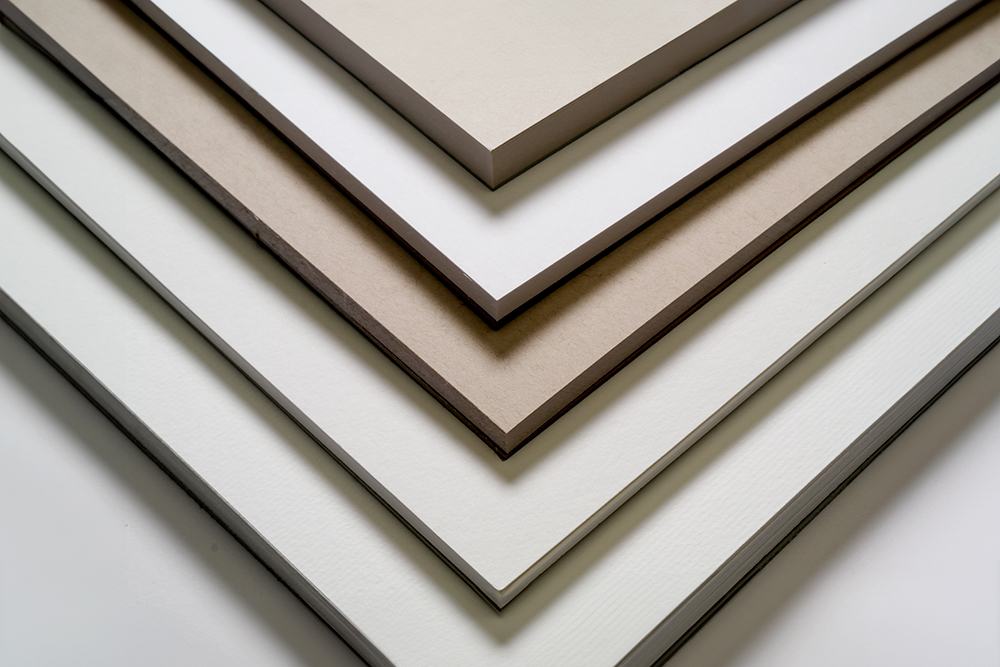
One of the main non-vegan ingredients to look out for when buying paper is gelatine sizing. Papermakers use this bone-glue to treat paper and control its absorbency. Some manufacturers are moving towards using synthetic alternatives, like AKD (Alkyl Ketene Dimer), so there’s certainly no shortage of papers suitable for vegan artists.
Some adhesives used in bookbinding contain animal-derived materials, so occasionally you may find that some stitched sketchbooks aren’t vegan. We asked our suppliers about this and all said that they don’t use animal-derived adhesives, but it is something you’ll want to keep an eye out for.
Although some papers do not contain gelatine size, some of these papers use woollen felts. While the paper sheets don’t contain wool as an ingredient, some vegan artists opt to avoid these papers due to the utilization of animal materials in the manufacturing process.
Our suppliers prime all our canvases with acrylic gesso rather than traditional gesso, and the manufacturer’s state that, to their knowledge, they don’t use any animal adhesives.
| RANGE: | EXCEPTIONS: |
| Hahnemühle | None |
| Fabriano | None |
| Strathmore | None |
| Canson Papers | Mi-Teintes |
| Clairefontaine | None |
| Winsor & Newton Paper | Professional Watercolour, Watercolour, Mixed Media, Pastel and Smooth Surface Drawing Paper |
| Daler-Rowney Paper | Langton Prestige, Murano |
| YUPO | None |
| St. Cuthbert’s Mill | Saunders Waterford |
| Winsor & Newton Canvas | Linen Canvas |
| Loxley Canvas | None |
| Liquitex Canvas | None |
| Ampersand Panels | None |
| Viviva Sketchbooks | None |
| Snowdon Cartridge Paper | None |
Arches use gelatine sizing across all their paper ranges, as does Canaletto so none of these surfaces are suitable for vegan artists.
Vegan Painting and Drawing Accessories
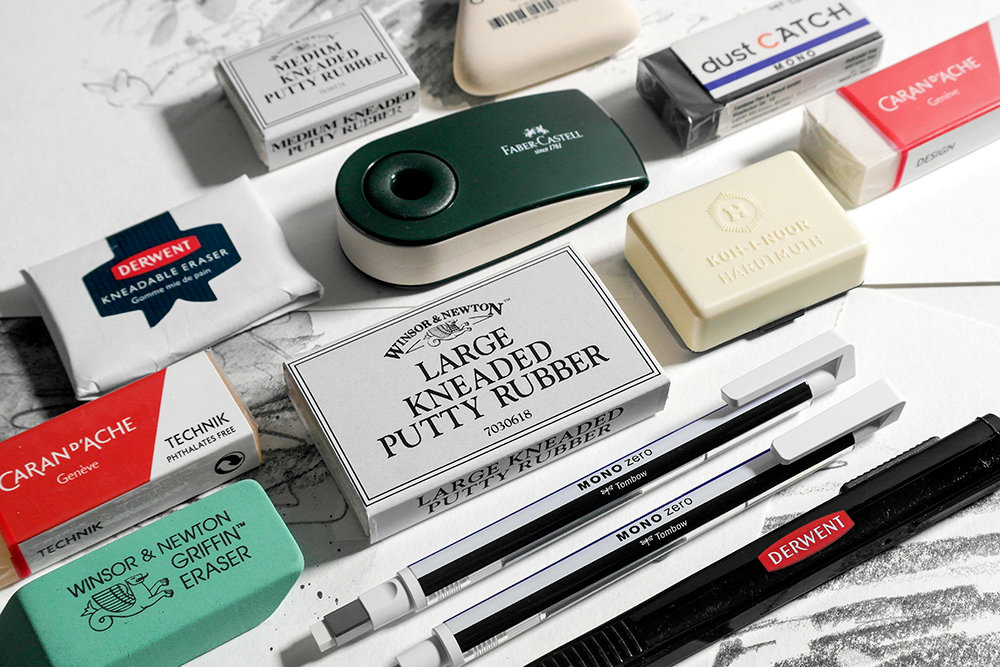
Most of our painting and drawing accessories are suitable for vegan artists. However, any accessories containing leather are unsuitable for vegan artists. This includes accessories like our Mahl stick, some pencil cases and leather bound books. Spectrafix Degas Pastel Spray Fixative is also unsuitable for vegan artists as it contains casein. For ethical as well as environmental concerns you may also choose to avoid using natural sponges.
Disclaimer
Unfortunately manufacturers can change their ingredients without warning. While we do try to keep on top of these changes, some do slip through the net. All information was correct at the time of publishing, but please let us know if there is something you think we need to check. Please note that our lists only cover the art materials that we currently stock.
Some manufacturers didn’t reply to our requests for information about their ingredients, so they aren’t in our lists. Additionally, some manufacturers state that their products were vegan to their knowledge, but they couldn’t guarantee that the raw materials they use don’t undergo animal testing. Faber-Castell were the only brand that explicitly stated that even their packaging is free from animal-based glues.
This list is by no means exhaustive. Think there’s something we stock that’s missing from the list? Please let us know and we’ll add it on! And if you found your favourite vegan art materials missing from our website please let us know – it could be something we’ll stock in the future!
You won’t have to compromise compassion for quality
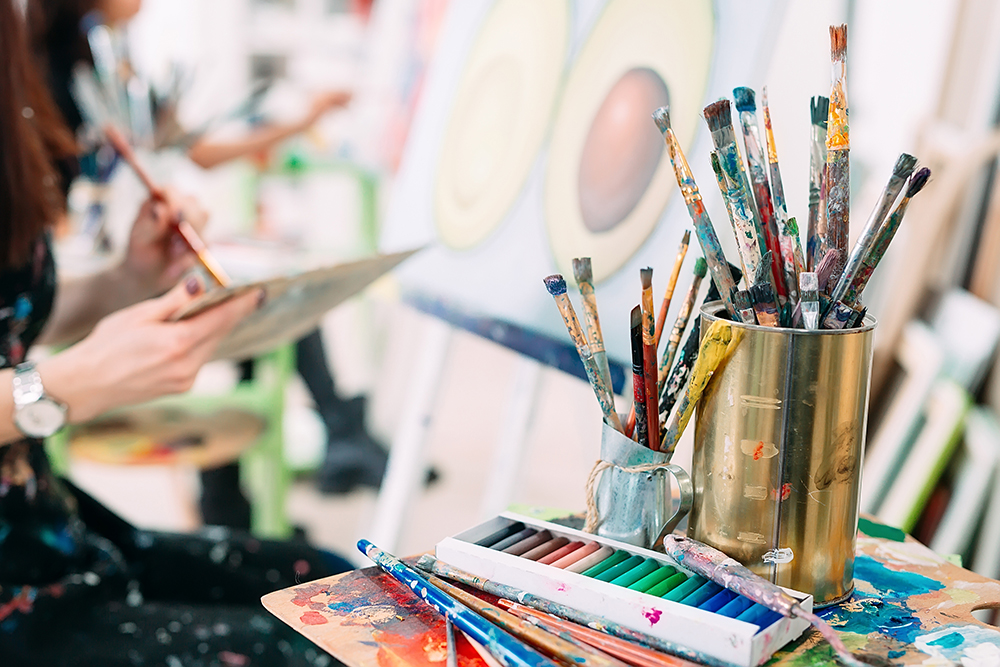
We hope our blog post makes shopping for vegan art materials easier! It’s now easier than ever to make conscious purchasing decisions so that your materials fall inline with your lifestyle. Remember, we’re all human; slip-ups happen. So, if you mistakenly purchase something doesn’t perfectly align with your values, don’t be too hard on yourself. Embrace progress, not perfection! Be sure to visit our website and shop for a wide variety of vegan art materials to kickstart your creativity!
Resources
Below is a list of the public resources provided by our suppliers outlining their vegan products and/or animal testing policies.
- Daler-Rowney Animal Derived Ingredients & Animal Testing Policy
- Derwent Art Materials Vegan Friendly Products List (updated June 2024)
- Royal Talens Vegan Art Materials List
- Schmincke Vegan Art Materials List
- Are Liquitex Materials Cruelty-Free and Vegan Friendly?
- Golden Artist Colors Animal Ingredients and Animal Testing Statement

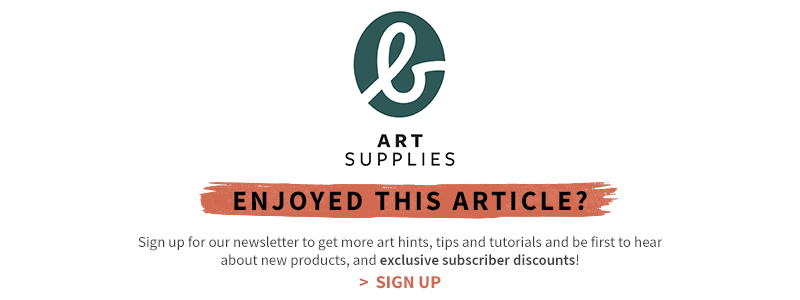

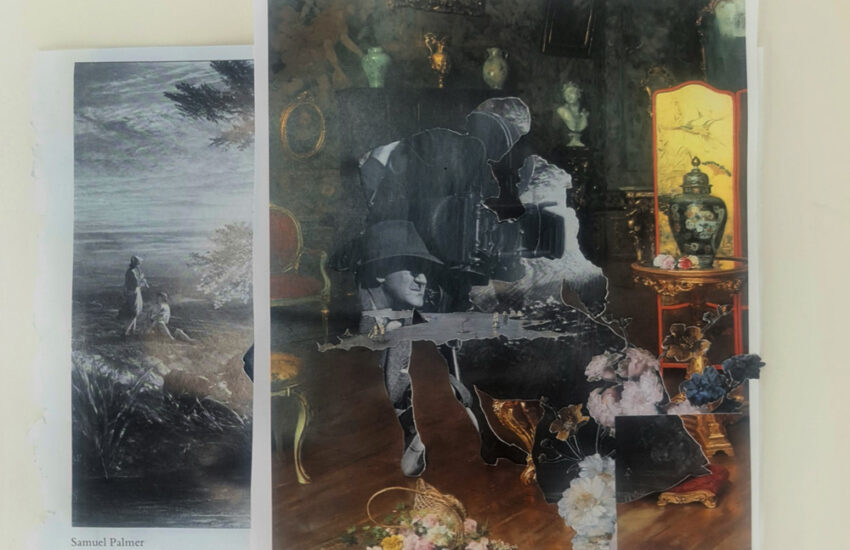

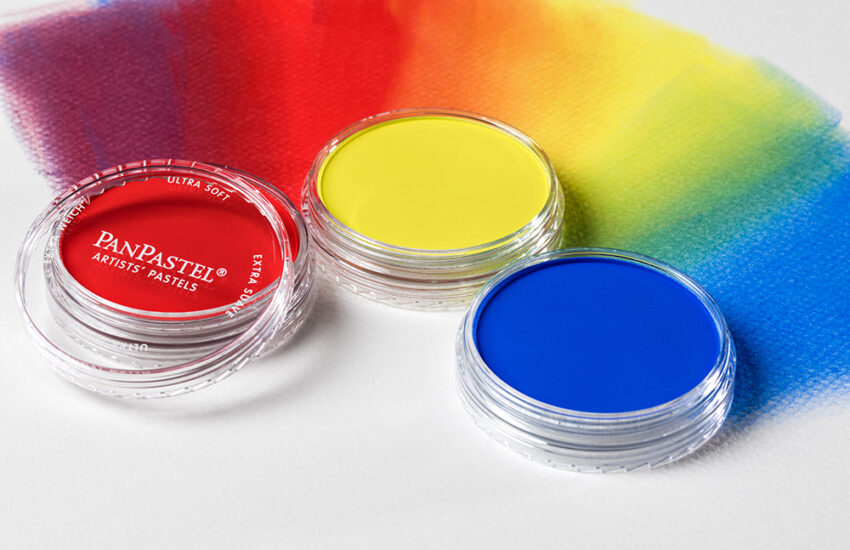


Hello – thanks for this list … super helpful.
Though, I wondered why you’ve got Daler Artist’s watercolour ad non-vegan? According to the download (bottom of article) you link to, they are all non-animal derived/tested, with the exception of the black pigment.
Is there something I’ve missed?
Cheers
Hi CJ. Thanks for pointing this out! It looks like I missed it when Daler-Rowney updated their list. I’ll amend the blog post now so the Daler-Rowney Artists’ Watercolours are added to the vegan-friendly list.
Thank you so much for taking the time to build such a wonderful list of vegan friendly materials. So appreciated and saving this to keep referring back to! Many thanks from the animals and planet!! 🙂
😊
this is a super helpful list, thank you
Thanks for your comment Louisa! Happy to hear that you found our list useful.
This is the best list ever !!!! My search stops here. Thank you, Alice
Great article, I really appreciate the information.
Thanks Trudi! Happy to hear that you found the article useful!
THANK YOU! Finally, a comprehensive article answering these important questions. Now, I’m not a vegan (I know artists who are), but I’ve never been comfortable about the ‘best’ sable brushes. No one could ever answer where sable comes from and whether it’s a by product of the meat industry. I never used them and love the synthetic brushes. All the information in this article is so greatly appreciated. I will be sharing it to people I know👏🏻 💐 💕
Hi Jackie! Thank you for your kind words! We’re thrilled you found the article helpful. Your feedback means a lot to us, and we’re delighted that synthetic brushes are working well for you. They’ve certainly come a long way since they were first introduced! Thanks so much for sharing the article with others.
Gutted that the Derwent Drawing pencils are not vegan, as the white is the brightest white I have found for drawing on coloured paper. I’d be interested to know what the animal-derived ingredient(s) is in this range.
Hi Sarah. Thanks for your comment! We’re sorry to hear about your disappointment regarding the Derwent Drawing Pencil range. Typically, non-vegan pencils contain ingredients like animal fat to make the core. However, we’ve had positive feedback about the Caran d’Ache Museum Aquarelle pencil in white, which is vegan and can be whiter on certain surfaces. Perhaps it’s worth giving it a try if you’re open to using water-soluble pencils.
Very useful information greatly appreciated.
Hi Georgina. Glad to hear your found the blog post useful!
Thank you for this often overlooked information.
Hi Neal. It’s no problem at all! Hope this information is useful.
Given plastics are poisoning the entire earth and its inhabitants, could you please do a similar article on avoiding plastic which ironically is probably the only alternative to animal products at present? I feel like you can either hurt specific creatures or poison everything.
Hi Heather. Thanks for your comment and feedback! We appreciate your concern about plastics and their impact. We’ve received similar inquiries and have noticed suppliers exploring plastic-free alternatives. We’ll definitely explore this further in future articles. Stay tuned!
Excellent, and up to date info, thanks so much 🙂
Hi Jude. Thanks for the feedback! We’re glad to hear you liked the blog post.